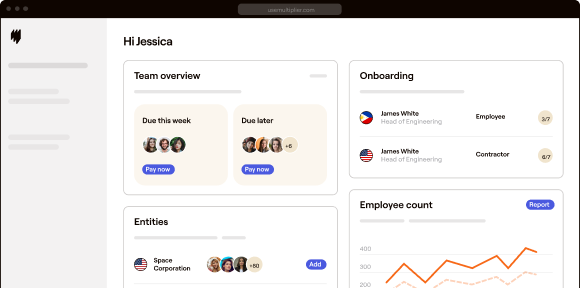Managing payroll is essential for businesses of all sizes, but it can be a complex and time-consuming process. Many companies use HRIS (Human Resources Information System) platforms to streamline and automate payroll processes. With various types of HRIS systems available, it can be challenging to determine which one is the right fit for your business needs and budget.
In this blog post, we’ll provide a comprehensive guide to inform the audience about the different types of human resource information systems available, highlight the key features and functionalities of each HRIS type, and guide businesses in choosing the most suitable HRIS system for their specific needs.
Types of HRIS systems
There are three types of human resource information systems: on-premises, cloud-based, and open-source HRIS. Let’s explore each type in detail:
On-premises HRIS
Of all the types of HRIS systems, on-premises HRIS is the most traditional HR management system. It’s installed and runs on the company’s own servers, giving the business total control over the system. This HRIS type is best suited for mid-market and enterprise businesses that require high customization options and already have in-house IT infrastructure to support the system. Usually, those with 100 employees or more.
The benefits of on-premises HRIS systems include:
- Data Control: Since the data is stored on-site, businesses have complete control over their sensitive HR data.
- Customization: On-premises systems often allow for greater customization than cloud-based solutions.
- Integration: On-premises HRIS can often be more easily integrated with other on-site systems. This can lead to better data consistency and process streamlining across the organization.
- Security: While cloud-based solutions have made significant strides in security, some businesses may still feel more comfortable knowing their data is stored on-site under their own security measures.
According to a report from 2022, the average cost of HRIS systems is approximately $12,625 per user or $210 per user per month. For small companies with up to 49 employees, the average annual budget allocation is around $6,000.
Cloud-based HRIS
A Cloud-Based HRIS is a web-based system hosted by the service provider and accessed via the Internet. It provides small and medium-sized businesses with scalability, flexibility, and accessibility. Usually best suited for businesses with less than 100 employees or those with remote/global employees. Notable features of Cloud-Based HRIS include automatic updates, an intuitive user interface, and reduced upfront costs.
Beyond this, cloud-based HRIS offers several benefits that can revolutionize workplace efficiency, productivity, and engagement. These include:
- Predictive analytics: These systems include analytics features that can help businesses make data-driven decisions and predictions.
- Real-time performance monitoring: Cloud-based HRIS allows for real-time employee performance tracking and assessment.
- Increased employee engagement: Features like self-service portals and digital communication tools can increase employee engagement.
- Accessibility and flexibility: These systems are hosted in the cloud and can be accessed from anywhere, providing flexibility for remote or mobile employees.
- Centralized platform: Cloud-based HR systems centralize all HR data and processes, enhancing organizational communication and consistency.
- Security: These solutions are typically designed with strong security measures, including data encryption.
- Improved recruiting: Many cloud-based HR systems include features that can streamline the recruitment process, such as applicant tracking systems.
- Compliance: These systems can help businesses maintain compliance with labor laws and regulations and improve the accuracy of HR data.
- Managing remote teams: Cloud-based HR software provides a new way to manage remote teams, which is increasingly important in today’s work environment.
Each of these benefits can contribute to more effective and efficient HR management, though the advantages may vary depending on the specific system and the business needs.
Compared to types of human resource information systems, cloud-based is best suited for businesses that require mobility and flexibility and do not have in-house IT support. For example, companies operating remotely or with a global workforce benefit immensely from cloud-based solutions.
The average cost of implementation can range from $50 to $200 per employee per year. Some notable providers in the market include BambooHR and Gusto.
Open-source HRIS
Open-source HRIS is a free, customizable, and open-source platform that enables businesses to modify, integrate, and host software as per their specific needs. Open-source HRIS empowers businesses to create their own custom HR solution and tailor it to their unique business needs without vendor lock-in.
Open-source HRIS offers several benefits:
- Cost Savings: Open-source software is usually free to obtain.
- Customization: Since the source code is openly available, businesses with coding knowledge can customize the software to fit their specific needs.
- Community support: Open-source software frequently benefits from a community of users and developers, offering support and collaborative problem-solving.
- Innovation and updates: The open-source nature allows for frequent updates and innovative community-driven features.
- Flexibility: Open-source HRIS offers flexibility as it can be hosted on the cloud or self-hosted.
Remember, while open-source HRIS can offer these benefits, they also require technical expertise to implement and maintain. It’s crucial to consider this when deciding on an open-source solution.
This HRIS type is best suited for businesses that require a low-cost or free HRIS solution and have in-house IT support. The average cost of implementation can vary widely from no cost to significant in-house development costs, depending on the business’s IT capabilities. Some notable providers in the market include OrangeHRM and Sentrifugo.
Now that we have covered different types of HRIS systems, let’s compare and differentiate each type with the below table:
| Consideration | On-premises | Cloud-based | Open-source |
| Business size | 100+ | 100 or less | All sizes |
| Data protection | You control your company’s data on-site. This is an ideal solution if sensitive data should stay in-house. | Preferred by companies with sensitive data who prefer to transfer responsibility for securing it to a trusted source. | As open-source HRIS systems are often free and offer fewer benefits, data protection/privacy isn’t as reliable as cloud or on-premises solutions. |
| Updates/fixes | Finding patches and paying for upgrades is manual. This is best suited for organizations with a well-established IT unit and a proficient IT team equipped to handle these tasks efficiently. | No manual upgrades are needed, and it’s typically free of charge. The SaaS solution provider handles installation, upgrades, and maintenance with utmost care and efficiency. | Open-source projects thrive on the collaborative efforts of developers and users. This support network provides ongoing updates, bug fixes, and other resources. |
| Cost | While the initial investment cost may be high, the subsequent expenses are minimal, making it a cost-effective choice in the long run. | Implementation costs are lower, and these types of HRIS systems are subscription-based. Therefore, it’s crucial to consider long-term costs when choosing an HRIS solution. | While numerous open-source HRIS options are free, it’s important to consider potential expenses tied to implementation, customization, support, and maintenance. |
| Flexibility and scalability | Accessing additional software packages and hardware costs more. Also, the process of installing, preparing, configuring, and implementing the software also requires time and effort. | Rapidly expanding businesses require a flexible system that can effortlessly scale up. By operating on a contract basis, the cloud-based system offers the advantage of only paying for what you use. | Open-source HRIS are highly customizable, allowing organizations to tailor it to their needs and adapt as the business grows. |
Common pitfalls when deciding between types of HRIS systems
To avoid common pitfalls, businesses should assess their needs, budget, and IT infrastructure first. It’s important to research different HRIS systems and vendors, check customer reviews, and seek recommendations from industry peers. Businesses should also look for features that align with their specific needs, such as payroll management, benefits administration, or performance management.
It’s also crucial to understand the implementation and ongoing maintenance costs of each HRIS system and align it with the business budget. Finally, businesses should test the HRIS system before implementation to ensure it meets all the business requirements. To do so, most leading providers will allow you to book a free demo.
Enhanced payroll and HR with Multiplier
Several types of HRIS systems offer a valuable solution for managing payroll and HR processes. By understanding the different types of HRIS systems, their functionalities, and features, businesses can choose the right HRIS system for their needs.
Multiplier is a comprehensive HRIS that streamlines every imaginable human resources process. It effortlessly facilitates seamless international payroll and optimizes the onboarding experience. Multiplier’s platform is also renowned for its robust security and compliance features and industry-leading employee self-service offerings.
Want to know more? Talk to our experts.
FAQs
Q. Is open-source HRIS suitable for small businesses?
Yes, open-source HRIS can be a good fit for small businesses. They offer flexibility and scalability that can be beneficial for growing organizations. However, small businesses should also consider the technical expertise required to implement and maintain an open-source system.
Q. Can HRIS systems integrate with other business software?
Most HRIS systems are designed to integrate with other business software. This includes payroll systems, performance management tools, and time-tracking software. Integration capabilities can significantly enhance the efficiency of your operations.
Q. Are there any security concerns with cloud-based HRIS?
While cloud-based HRIS has many advantages, there are potential security risks. These include data breaches, unauthorized access, and data loss. It’s important to ensure your provider uses robust security measures, including encryption, firewalls, and regular security audits.
Q. How often should an organization update its HRIS system?
It depends on the organization’s needs and the system in use. However, as a rule of thumb, reviewing your HRIS system at least once a year is advisable to ensure it meets your needs and takes advantage of any new features or updates.
Q. What role does user training play in successful HRIS implementation?
User training plays a crucial role in successful HRIS implementation. Without proper training, employees may not use the system effectively, leading to reduced productivity and potential errors. A comprehensive training program can help ensure all users understand how to use the system and its features.







